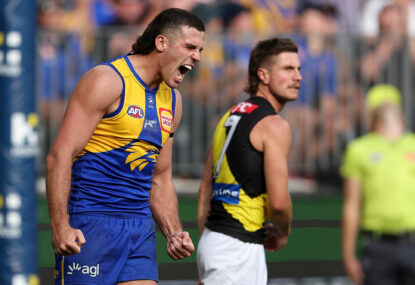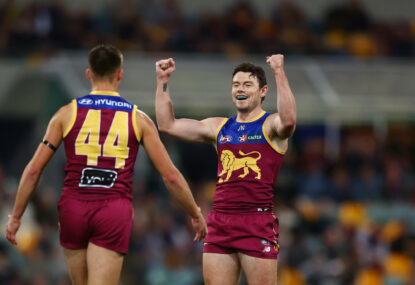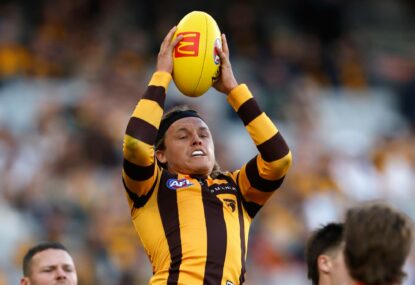The AFL’s now traditional Indigenous Round caused its now traditional controversial moment from its now traditional controversial player. The following seven thoughts are anything but traditional.
1. Seen that dance before
In an argument that has divided the football public and the broader community, it is amazing that the act of a ‘War Dance’, as performed by Adam Goodes on Friday night, largely hasn’t been discussed.
The general conversation has been to analyse Goodes’ character rather than understand why the act has created such a reaction.
Even those with a passing interest in an AFL pre-season will know that the Indigenous All Stars play a match every second year against an AFL side. Back in February this year that match was against West Coast. Prior to the bounce of the ball the entire Indigenous All Stars team performed Goodes’ War Dance as a line towards a line of West Coast opponents. The reaction at the ground to this was one of pride from Indigenous people, and there was warm applause at its completion.
Indeed Goodes’ two comparisons when explaining his act were the Flying Boomerangs and the All Blacks, which are logical comparisons to draw. Where Goodes missed the mark though, was that these traditional acts happen is in a controlled environment.
Both the examples Goodes gave happen prior to the match as a way to build intimidation in an opponent while also being respectful of the contest itself. Goodes’ act was that of an individual and lacked respect for the contest. Simply put this was about it being performed in an uncontrolled environment as opposed to a controlled environment.
Goodes is fortunate that the AFL is a professional sport and no player was likely to take action against his ‘War Dance’, but feel for the impressionable Indigenous youngster who does this at a community ground at the weekend and is targeted for his actions.
Goodes’ act was a fitting tribute of his proud Indigenous heritage, but it was performed at an inappropriate time.
2. Fremantle’s historic run draws to a close
I had hoped that The Roar’s analytical expert Ryan Buckland would look at the historical seven-week stint that Fremantle just had. Selfish because it would have given legitimate and quantified research, as opposed to this haphazard research.
Still, here goes…
Fremantle arguably just produced the most dominant seven-week run since the all-conquering Essendon team of 2000, and perhaps most dominant seven weeks ever.
Between Rounds 2 and 8 they trailed in a match for six minutes and 25 seconds. That is right, they trailed for less than a minute a game over seven weeks. In five games over that run they never trailed, securing wire-to-wire wins against West Coast in Round 3, Sydney in Round 4, Melbourne in Round 5, Western Bulldogs in Round 7 and North Melbourne in Round 8.
The closest to this level of dominance was Essendon back in 2000, but even they appeared to have a week every six weeks or so where they were forced to come from behind. Indeed, when Adelaide led at quarter time it ended a run of 29 quarters in which Fremantle were in front. The only clubs that led Fremantle at a quarter break in the opening nine rounds are the two Adelaide clubs.
Would love to see the exact numbers but for now, remember that this is a one-team premiership race. Seven weeks, six minutes 25 seconds – tells you all you need to know about their clinical dominance in 2015.
3. Scoring is steadily returning
The first five weeks of the season continued a disappointing trend from the past couple of seasons of a sharp descent in scoring. After Round 5 scores were at extraordinarily low levels of just 85 points per team per game.
Over the past month though, a couple of rising teams are starting to legitimise attacking and free-flowing football again.
In his second season at the helm Adam Simpson has engineered the number one offence in the game, with West Coast leading points for. Simpson’s style is similar to the recent benchmark of Hawthorn who continue to be a potent attack. Collingwood are another club that is flourishing with a new attacking game plan and rank third in points for.
At the weekend you even saw previous battlers St Kilda and Western Bulldogs pass the ton.
Again, in a league that has been more concerned with defence for so long, its refreshing that coaches are finally returning to attack-first football.
4. Goals are as good as ever
With that return of scoring has also come a return of great goals being kicked, seemingly on a weekly basis. This year has seen at least five goals that were better than any of the goals that won goal of the year in recent years.
On Saturday night alone there were another two legit contenders for goal of the year.
Eddie Betts continued his quest to be this generation’s Peter Daicos with a freak, 50-metre torpedo slash checkside goal, while Michael Barlow’s goal in the same game was arguably even better.
Given the state of the game it was hard to argue there has been a more clutch moment and goal then what Barlow delivered in a low-scoring and tense final quarter.
5. North’s call for heads rolling
Perhaps a temporary change of coach is a good thing for North Melbourne and they will be able to follow through on what has been thinly veiled threats of changes.
so far in 2015 North Melbourne have surrendered meekly against Adelaide, Hawthorn, Fremantle and now Collingwood. After each of those first three losses Brad Scott spoke of mass changes to address poor performance, and on all three occasions those changes were limited.
North Melbourne’s season is in danger of slipping away and real change could come in the way of interim coach Darren Crocker.
6. Six-year itch
Speaking of Crocker, his rise back to coach, albeit on an interim basis, after six years is perhaps one of the more remarkable stories in the dynamic world of AFL coaching. Crocker of course was Scott’s predecessor as North’s interim coach at the end of 2009.
Crocker did speak of his desire for the permanent role in 2009 yet has proven to be loyal to the club by remaining as an assistant under Scott. Now he will get a second crack at impressing at the senior level.
His record is a mediocre 3-1-6, but boy could North Melbourne do with another three wins over the next month.
7. A failed Gold Coast
This week Rodney Eade has flagged wholesale changes on the Gold Coast list at season’s end, with the second half of 2015 a test for who in the young squad wants a place.
What this really suggests is that the AFL’s venture onto the Gold Coast and the raft of draft concessions offered were a failure. Gold Coast simply has not been able to make good on the generous offer of the AFL and it appears the error is compounded by the bullishness of Eade.
Regardless of whether it is termed a build or a rebuild, the grim reality is that Gold Coast is now stuck with a number of other bottom-feeder clubs, simply dreaming of September success.


































































































